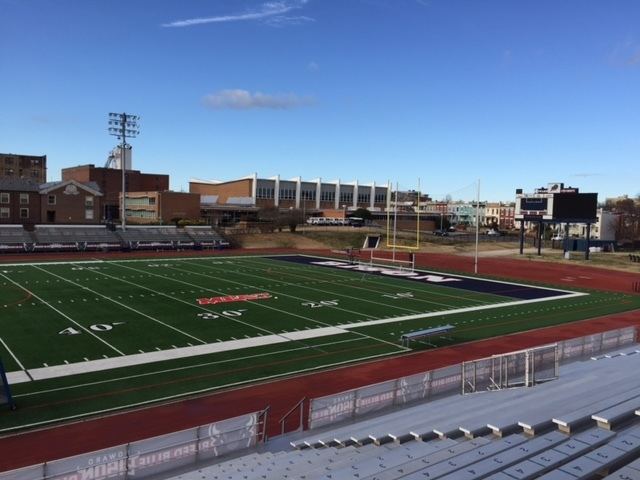Former names Howard Stadium Surface Sprinturf Built October 16, 1926 Opened 1926 | Broke ground 1926 Capacity 7,086 Phone +1 202-806-7140 | |
 | ||
Location 2400 6th Street NorthwestWashington, D.C. 20059 Address Howard University, 2400 6th St NW, Washington, DC 20059, USA Similar Burr Gymnasium, Gen Oliver Otis Howard, Founders Library, Hughes Stadium, O'Kelly–Riddick Stadium | ||
William h greene stadium top 18 facts
William H. Greene Stadium is a 7,086-seat multi-purpose stadium in Washington, D.C., in the United States, which opened in 1926. It is home to the Howard University Bison football and soccer teams. Originally called Howard Stadium, it was renamed William H. Greene Stadium in 1986 in honor of William H. Greene, M.D., a Washington, D.C., physician.
Contents
Howard Stadium
Where the stadium stands today was formerly a middle-class African American neighborhood which was home to many Howard University faculty and workers. Howard University completed its new Howard Stadium in July 1926. The first football game played there was on October 16, 1926, against Morehouse College. The 2,000-seat Howard Stadium was clearly too small for Howard football games. Howard played most of its games at nearby Griffith Stadium, where crowds of 17,000 to 20,000 people were common from the 1920s into the 1960s. (Griffith Stadium was demolished in 1965.) Afterward, Howard University played most of its home games at Robert F. Kennedy Memorial Stadium (also known as RFK Stadium).
By 1977, Howard Stadium had been renovated and expanded to seat 9,000. That year, Howard University officials proposed constructing a 20,000-set stadium to replace the aging facility. Howard University officials admitted that Friday night football games did not draw large crowds, and the university could not get many Saturday afternoon games at RFK Stadium. (The Washington Redskins rented RFK Stadium, and a clause in their contract prohibited the playing of any game in the stadium 24 hours before a Redskins game.) In 1979, Howard University president James E. Cheek announced a plan to build a $14 million stadium and parking garage to replace Howard Stadium. The proposed stadium would seat 20,000. The university said it alread had a design, and blueprints were being drafted. But nothing came of this plan.
A decade later, Howard University officials announced an even more grandiose plan. In 1986, the university said it proposed constructing a 30,000-seat domed stadium. An office building, retail space, and more than 1,200 apartments would be built as part of a "Howard Plaza" project on 20 acres (81,000 m2) of abandoned and dilapidated property next to the campus. The Howard Plaza project had a $150 million price tag. The stadium alone, which was designed to host football and basketball games, would cost $75 million. Although the plan had the support of city officials, critics of the plan noted that Howard's football games only drew about 4,000 to 7,000 attendees. Residents of nearby LeDroit Park also opposed the plan.
William H. Greene Stadium
Nothing came of the 1986 domed stadium plan. Instead, Howard Stadium was renovated in early 1987, and renamed William H. Greene Stadium. New bleachers were installed, and a new artificial turf surface emplaced. As of 2011, the team still played on an artificial surface.
In 1990, Howard University officials proposed to expand Greene Stadium by 6,000 seats in 1991 season. The plans called for enclosing the north end of the stadium, and moving the scoreboard to the south end. This would provide the stadium with a total of 14,000 seats, enabling the university to sell season tickets because it could guarantee preferential seating. By 2010, however, Greene Stadium still had not been expanded or renovated.
In a review of D.C. area stadiums in 2013, Brett Fuller, director of business development at the architectural firm AECOM, heavily criticized Greene Stadium for looking more like a high school field than a major college football stadium. As for the need for renovation, Fuller said, "It's hard to say it's in bad shape. It hardly exists at all."
